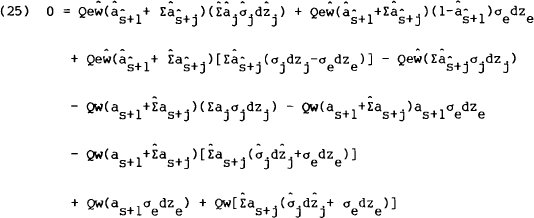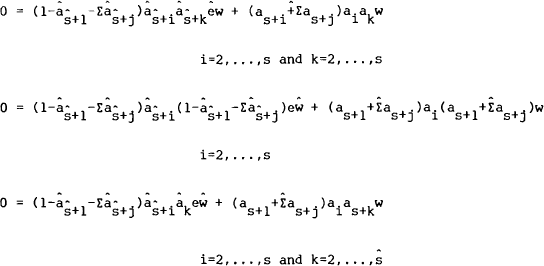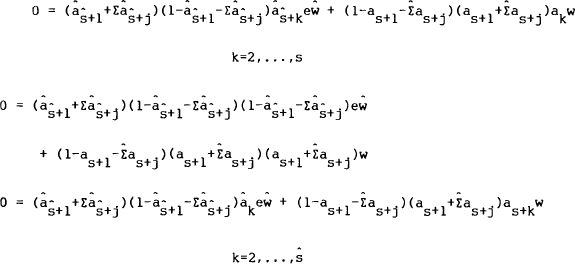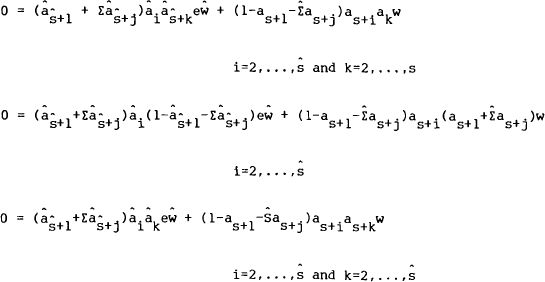RDP 8610: Equilibrium Exchange Rates and a Popular Model of International Asset Demands: An Inconsistency 5. Example: Many Assets
July 1986
The above results will now be generalised to show that the equilibrium solution for (the
stochastic part of) the exchange rate process in these models continues to be a function only of
the stochastic parts of the processes for asset prices and therefore that the model is
internally inconsistent. Assume that in addition to a real riskless asset in each country, there
are (S−2) other assets of which (s−1) are supplied by the home country and  are
supplied by the foreign country. Depending on his nationality, an investor will face the
investment opportunity sets,
are
supplied by the foreign country. Depending on his nationality, an investor will face the
investment opportunity sets,
| Home Country | Foreiqn Country |
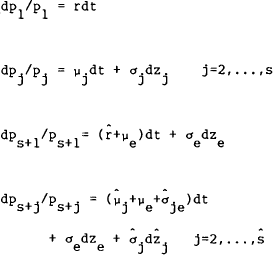 |
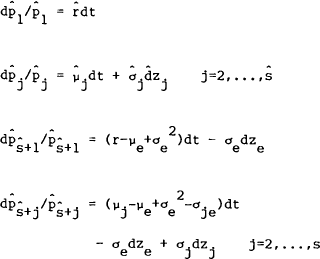 |
where  In
terms of the general model of Section 2, these equations define,
In
terms of the general model of Section 2, these equations define,
for the home country and,
for the foreign country. These definitions may then be used to obtain the optimal asset shares
a and  from equation (17) and the processes for wealth,
from equation (17) and the processes for wealth,
where ∑ denotes the sum over j=2,…s and  denotes the sum
over
denotes the sum
over 
Equilibrium in the asset markets is defined by equation (8) above. In this version of the model these market clearing conditions become,
The balance of payments equilibrium condition, equation (9), may be rewritten as,
As previously, for this equation to hold, both the drift (or dt) terms and the noise (or dz) terms on each side of the equation must be equal. Consider the noise terms,[29]
which can only be true if one of the σdz's is a linear combination of the others, or if the coefficients on each σdz term sum to zero. The second possibility requires that,
for the coefficients of −σidzi,
for the coefficients of σedze and,
for the coefficients of 
These constraints must hold for all tε[0,∞). Hence Ito's Lemma may be applied
to differentiate both sides of each of these relationships. Since the aj's and
 's are
constant, this again means that the coefficients on each of the σdz in the resulting
weighted sums of
's are
constant, this again means that the coefficients on each of the σdz in the resulting
weighted sums of  and dw must be zero. Differentiating equation
(26a) gives,
and dw must be zero. Differentiating equation
(26a) gives,
Similarly, equation (26b) requires that
and differentiating equation (26c) gives,
This process of differentiation and equating coefficients on the different σdz terms may
again be repeated ad infinitum. Notice that the term  is the
foreign country's total holdings (in terms of budget shares) of home country assets and the
term
is the
foreign country's total holdings (in terms of budget shares) of home country assets and the
term  is
the home country's total holdings of foreign assets. There are thus only three
possibilities. Either the price processes are such that each country holds none of the others'
assets, ever (that is, the “own” assets completely dominate the “other”
assets), or each country holds all of its wealth in a single asset. Neither of these is an
admissable solution to a model that is intended to explain international portfolio holdings. The
third possibility is that at least one of the following equations must hold,
is
the home country's total holdings of foreign assets. There are thus only three
possibilities. Either the price processes are such that each country holds none of the others'
assets, ever (that is, the “own” assets completely dominate the “other”
assets), or each country holds all of its wealth in a single asset. Neither of these is an
admissable solution to a model that is intended to explain international portfolio holdings. The
third possibility is that at least one of the following equations must hold,
However, given the asset market equilibrium conditions in equation (23), the first of these conditions will hold if and only if the total supply of home country assets is zero, and the second requires that total supply of foreign country assets to be zero. Clearly, neither of these can apply. Hence, neither do the constraints in equation (26).
Therefore, the only solution to the stochastic part of the balance of payments constraint (equation (25)) is that one of the σdz terms is a linear combination of the others – i.e., that the real exchange rate dz may be expressed as a function of the asset price dz's. This implies that the investment opportunity set, as it is perceived by either agent, is spanned by (S−1) of the S assets and that the covariance matrix of excess returns, Ω in equation (7), is singular. Hence the S assets are not distinct and the original maximisation problem is misspecified.
Footnote
The coefficients on the σQdzQ terms in equation (24) cancel out. [29]






